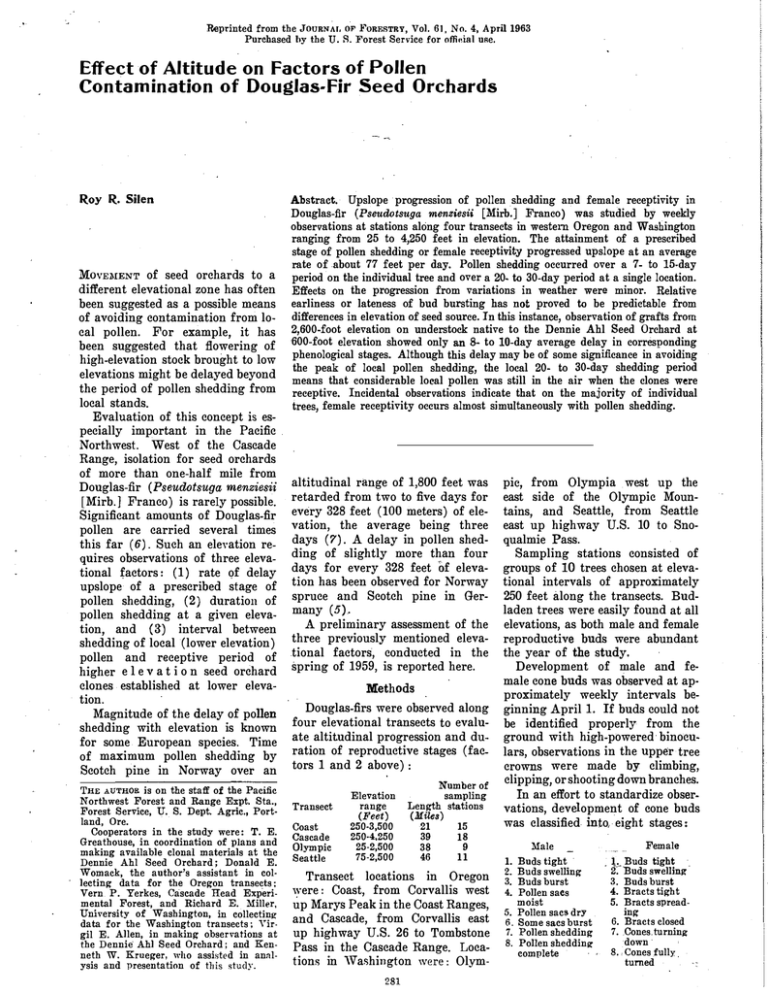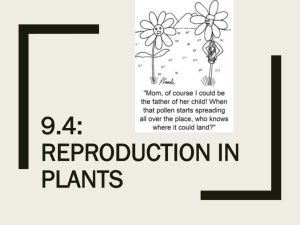JOURNAJ, OF Ji"'oRESTRY, April 8.
advertisement

RepTinted from the JOURNAJ, OF Ji"'oRESTRY, Vol. 61, No. 4, April 1963
Purehased by the U. 8. Forest Service for offir-ia.1 uRe.
Effect of Altitude on Factors of Pollen
Contamination of Douglas-Fir Seed Orchards
R.oy R.. Silen
MovE>IENT of seed orchards to a
different elevational zone has often
been suggested as a possible means
of avoiding contamination from lo­
cal pollen. For example, it has
been suggested that flowering of
high-elevation stock brought to low
elevations might be delayed beyond
the period of pollen shedding from
local stands.
Evalnation of this concept is es­
Abstract. Upslope progression of pollen _shedding and female receptivity in
Douglas-fir (Pseudotsuga menziesii [Mirb.J Franco) was studied by weekly
observations at stations alOng four transects in western Oregon and Washington
ranging from 25 to 4,250 feet in elevation. The attainment of a prescribed
stage of pollen shedding or female receptivity progressed upslope at an average
rate of about 77 feet per day. Pollen shedding occurred over a 7- to 15-day
period on the individual tree and over a 20 to 30-day period at a single location.
Effects on the progression from variations in weather were minor. Relative
earliness or lateness of bud bursting has not proved to be predictable from
differences in elevation of seed source. In this instance, observation of grafts from
2,600-foot elevation on understock native to the Dennie Ahl Seed Orchard at
600-foot elevation showed only an 8 to 10-day average delay in corresponding
phenological stages. Although this delay may be of some significance in avoiding
the peak of local pollen shedding, the local 20- to 30-day shedding period
means that considerable loeal pollen was still in the air when the clones were
receptive. Incidental observations indicate that on the majority of individual
trees, female receptivity occurs almost simultaneously with pollen shedding.
pecially important in the Pacific
Northwest. West of the Cascade
Range, isolation for seed orchards
of more than one-half mile from
Douglas-fir (Pseudotsuga menziesii
[Mirb.] Franco) is rarely possible.
Significant amounts of Douglas-fir
pollen are carried several times
this far ( 6). Such an elevation re­
quires observations of three eleva­
tional factors: (1) rate of delay
upslope of a prescribed stage of
pollen shedding, (2) duration of
pollen shedding at a given eleva­
tion, and (a) interval between
shedding of local (lower elevation)
pollen and receptive period of
higher e 1 e v a t i o n seed orchard
clones established at lower eleva­
tion.
Magnitude of the delay of pollen
shedding with elevation is known
for some European species.
Time
of maximum pollen shedding by
Scotch pine in Norway over an
THE AUTHOR is on the staff of the Pacific
Northwest Forest and Range Expt. Sta.,
Forest Service, U. S. Dept. Agric., Port­
land, Ore.
Cooperators in the study were: T. E.
Greathouse, in coordination of plans and
making available clonal materials at the
Dennie Ahl Seed Orchard; Donald E.
Womack, the author's assistant in col­
lecting data for the Oregon transects;
Vern P. Yerkes, Cascade Head Experi­
mental Forest, and Richard E. Miller,
University of Washington, in collecting
data for the Washington transects; "\.,.ir­
gil E. Allen, in making o.bservations at
the Dennie" Ahl Seed Orchard; and Ken­
neth W. Krueger, ·who assisted in annl­
ysis and presentation of tliis study.
altitudinal range of 1,800 feet was
retarded from two to five days for
every 328 feet ( 100 meters) of ele­
vation, the average being three
days (7). A delay in pollen shed­
ding of slightly more than four
days for every 328 feet of eleva­
pie, from
Olympia west up the
east side of the Olympic Moun­
tains, and Seattle, from Seattle
east up highway U.S. 10 to Sno­
qualmie Pass.
Sampling stations consisted of
groups of 10 trees chosen at eleva­
tion has been observed for Norway
spruce and Scotch pine in Ger­
tional intervals of approximately
250 feet along the transects. Bud­
many (5).
A preliminary assessment of the
laden trees were easily found at all
elevations, as both male and female
three previously mentioned eleva­
tional factors, conducted in the
spring of 1959, is reported here.
reproductive buds were abundant
the year of the study.
Development of male and fe­
Methods
male cone buds was observed at ap­
proximately weekly intervals be­
Douglas-firs were observed along
four elevational transects to evalu­
ate altitudinal progression and du­
ration of reproductive stages (fac­
tors 1 and 2 above) :
Transect
Elevation
range
Coast
Cascade
Olympic
Seattle
250-3,500
250·4.250
25·2,500
75·2,500
Transect
(Feet)
Number of
sampling
Length stations
(Miles)
locations
21
39
38
46
in
15
18
9
11
Oregon
were : Coast, from Corvallis west
up Marys Peak in the Coast Ranges,
and Cascade, from Corvallis east
up highway U.S. 26 to Tombstone
Pass in the Cascade Range. Loca­
tions in \Vashington 'vere: Olym281
ginning April 1. If buds could not
be identified properly from the
ground with high-powered binocu­
lars, observations in the npper tree
crowns were made by climbing,
clipping, or shooting down branches.
In an effort to standardize obser­
vations, development of cone buds
was classified into, eight stages :
Male
1.
2.
3.
4.
Buds tight
Buds swelling
Buds burst
Pollen saes
moist
5. Pollen sacs dry
6. Some sacs burst
7. Pollen shedding
8. Pollen sheddingo
complete
Female
1. Buds tight
- 2.-Buds swelling3. Buds burst
4. Bracts tight
5. Bracts spread­
ing
6. Bracts closed
7• .Cones. turning­
down·
8. . Cones full}'.
turned
JOURNAL OF FORESTRY
282
Male and f e m a I e numbered were made to compare elevation pollen shedding . and receptivity
stages were not chosen to neces­ and ( 1) earliest date of pollen progressed a 1 m o s t rectilinearly
sarily coincide in time of develop­ shedding, (2) date of estimated with elevation on every transect.
ment. In fact, after stage 3 in each maximum pollen shedding, (3) lat­ On three of the transects only, 6
case, there was considerable diffi­ est date of pollen shedding, and percent or less of the variation in
culty in pinpointing the stages be­ (4) date of estimated maximum time of first pollen shedding was
cause of variation over the tree or female receptiyity and elevation not connected with the regular up­
even on a single twig. Only the (Fig. 1).
slOpe progres_ sion computed for
stages "buds burst," apollen shed­
To evaluate the delay in flower­ each transect (correlation coeffi­
ding," and "bracts spreading" ing period of high-elevation stock cients [r] were 0.97 to 0.99). Even
could be judged with little bias. grown at low elevation, observa. on the Seattle transect where most
Hence analyses reported here are tions were made at the U. S. For­ variation occnrred, only 18 per­
confined to these stages.
est Service's Dennie Ahl Seed Or­ cent was similarly unexplained
chard near Shelton, Wash. This (r = 0.91).
An average stage was recorded
for each tree after all sides and orchard, at 600-foot elevation on
An example of the regression
the interior and exterior of its the Olympic transect, contains lines developed from the data is
crown were evaluated. The esti­ scions, originating from trees at shown for the Cascade transect
mated date pollen shedding began 2,600-foot elevation in the Cascade (Fig. 1) for which date and eleva­
and ended and the estimated date Range, grafted to local nnderstock. tion relationship for first pollen
of maximum female receptivity Observations of flowering stages shed, maximum pollen shed, last
(when the greatest number of fe­ were made at 2- to 5-day intervals. pollen shed, and maximum female
male cone buds were in "bracts
receptivity are indicated. Outer
Results
spreading" stage) were also re­
confidence limits (I-percent level),
With regard to altitudinal pro­
shown for date of first and last
corded for each tree. The average
date for each stage at each station gression of reproductive stages, pollen release, approximately de­
was computed. For each transect, slight delaying effects of cold rainy limit the total period that pollen
simple linear regression analyses weather were noticed, but time of would be shed from trees at a giv­
en elevation. On the other tran­
sects, regressions for these phenol­
ELEVATION C fee+I
ogical stages were essentially the
4,500
same ( Ta:ble 1).
Table 1 shows elevational pro­
4,000
gression with respect to develop­
3,i!IOO
ment of reprodnctive buds. Initial
pollen shedding progressed upslope
at rates of 62.0 to 82.6 feet per
day,
or an average for all tran­
2,500
sects of 77 .1 feet. Cessation of
pollen shedding progressed up­
slope at rates from 59.0 to 81.8
feet elevation per day, or an aver­
age of 76.7 feet. Since each tran­
sect is considered as an independ­
ent observation within a range of
'"
varied aspects and climates, statis­
tical differences between these rates
0
3
' .
... "c......o
.. .c":....c.;
' ''---"'',. :._....:
,
'';..__.,
-'=':._ ....:.:
"
' '
....::.....
were fonnd, as might be expected.
DATE:
April
Moy
June
However, no differences in rates
FIG. 1.-Elevational progression, duration of pollen shedding, and progression of
were fonnd that applied generally.
maximum female receptivity on the Cascade transect in western Oregon.
such as for coastal versus Cascade
or Oregon versus Washington.
Pollen shedding at a given eleva­
TABLE !.-DAILY RATE OF ELEVATIONAL CHANGE IN START, MAXIMUM, AND FINISH
OF POLLEN SHEDDING, AND IN MAxIMUM FEMALE RECEPTIVITT
tion occurred over a 20- to 30-day
period (Fig. 1). Individual trees
Average date of pollen
shedding at 250-foot
shed pollen over a period of 7 to
Maximum
Pollen shedding
elevational intervals
female
15 days, while the estimated recep­
Maximum
Finish
Ended
Start
receptivity
Transect
Began
tive period for individual trees, as
----- Feet per day ----judged by the spread bracts of fe­
71.4
79.7
72.5
April 2
April 22
Coast
68.6
male cones (stage 5 of the 8 re­
84.2
82.6
84.7
Caseade
April 2
April 22
90.9
corded stages), ranged from 5 to
71.3
April 19 May 3
59.0
Olympic
(')
(')
62.0
81.8
69.4
78.9
April 12 May 1
Seattle
12 days. Date of maximum pollen
77.l
78.5
76.7
76.7
Weighted average
shedding trailed the date of maxi­
1Each daily change was computed as a regression coefficient.
mum receptivity slightly on the
2No dates of maximum pollen release or receptivity were observed on the Olympic
three transects where estimates
transect.
·
APRIL 1963 283
were made, but such small differ­ and results of pollen Hight stud­
ences could . arise from sampling ies, serious contamination of seed
error.
orchards will be difficult to avoid
Only on the Seattle transect was by isolation within existing open
a slight decrease observed in dura­ areas ( 6). Thus, a difference in
tion of pollen shedding or recep­ flowering time between trees in a
tivity for individual trees at high­ seed orchard and those in the sur­
•!'. elevations. This corresponds to
rounding area is potentially im­
similar information obtained for
portant as an added safeguard.
Monterey pine in Australia (1),
T h i s p r e l i m i n a r y assessment
where initiation of pollen shedding
was reported to begin earlier and showsc that native trees adjacent
last longer at 200 feet than at to a given seed orchard would shed
2,000 feet. In that study, soil and pollen over a 20- to 30-day period.
air temperatures were the same in Similar variation within one local­
the two locations at the time of ity was found in a study on Van­
couver Island ( 4). In actual prac­
initiation.
Finally, the question of whether tice, however, a delay of 20 to 30
the rather large time lag in repro­ days in the female cone develop­
ductive stages of higher elevation ment of seed orchards in order to
trees would be maintained if these completely avoid local pollen does
trees were brought to low eleva­ not seem readily attainable. When
tions was answered for the Dennie Douglas-fir of higher elevation
Ahl Seed Orchard. Although the were brought together at a lower
parent trees at 2,600-foot eleva­ . elevation, they bnrst their buds
tion began to shed pollen about both earlier and later than local
May 14, in the seed orchard grafted stock (2). In the evaluation in the
material from these trees began to Dennie Ahl Seed Orchard at 600
shed pollen on May 2 and were feet, a delay of 8 to 10 days was
receptive on May 4. Pollen shed­ observed between clones from
ding on trees native to the orchard 2,600-foot elevation and local trees.
site began April 24, and averaged While the pattern may not be pre­
dictable from elevation of· seed
8 to 10 days earlier than that of
source
alone, the order of bnd
grafted stock for corresponding
stage of development. Thus, local bursting, once known, will be con­
pollen· was still abundant when sistent year after year (2) .
,Considering, in this instit.nce,
the clones ·in this seed orchard
that corresponding pollen shedding
were receptive.
stages progress upslope at a rate
Discussion
of about 77 feet per day, even an
In the light of the omnipresence 8- to 10-day delay might decrease
of Douglas-fir west of the Cascades contamination significantly within
·
·
the Dennie Ahl' Seed Orchard.
After 8 to 10 days, maximum pol­
len dispersion should be from
stands several miles away at 1,200
to 1,400 feet in elevation, and
local pollen shedding would be
tapering off. It can be seen that
this kind of protection might be
more effective if the orch rds were
surrounded by flat land rather
than adjacent to mountainside
Sources of contaminating pollen.
This study confirms a previous
observation (3) that, in a large
majority of the trees sampled,
female receptivity and pollen shed­
ding of Douglas-fir occur almost
simultaneously. In a few cases,
female receptivity preceded pollen
shedding, while in other instances
receptivity followed shedding of
pollen. Thus; dichogamy does not
appear to be characteristic of
Douglas-fir.
·
Literature Cited
1. MILLETT, M. R, 0. 1944. Pollen shed
of Monterey pine. Austral. Common­
wealth Forestry Bur. Lea.fiet 59. 8 pp.
2. MORRIS, WILLIAM: G., R. R. 8ILEN,
and H. lRoENB·MoLLER. 1957. Con­
sistencY o-f bud bursting ili Dou las­
fir. Jour. Forestry 55:208-210. Illus.
3. ORR-EWING, A. L. 1954. Inbreeding
experiments , with the Douglas fir.
Forestry Chron. 30: 7-20. Illus.
4. . 1956. Controlled Pollination
techniques for the Douglas fir. For­
est Sci. 2:251-257. Illus.
5. SOAMONI, A. 1949. Beobachtungen
Uber den Pollenfiug der Kiefer. und
Fichte. Foratwiss. Centbl. 68: 735-751.
6. SILEN, Roy R. 1962. Pollen dispersal
considerations for Douglas-fir. Joor.
Forestry 60: 790-795, Illus.
7. 8TRAN.D, L. 1957. Pollen dispersal.
Silvae Genetiea 6: 129-136.






